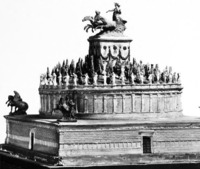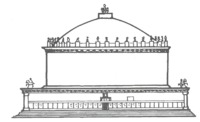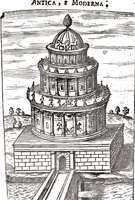Reconstructions
The construction of the original Mausoleum started around AD 123 and was completed by Hadrian’s successor Antoninus Pius in AD 139, a year after Hadrian’s death.1 Much of the ancient structure was lost during the conversion into the Castel Sant’Angelo, and many versions of the original structure were reconstructed based on the limited literary sources.2 Historian Procopius' record suggests that the original exterior of the square base was made of Parian marble, and the cylindrical drum above the base was made of travertine limestone and tufa. Historian Dio Cassius' writings suggest that a colossal quadriga (four-horse chariot) led by Hadrian and other statues of horses and men topped the drum.3 Three theories have been proposed regarding the original structure.
One theory considers the Mausoleum as consisting of a square base, a cylindrical drum with a gentle tumulus covered by a mound of earth and vegetation, and a structure on the very top.
The second theory claims that the tumulus is steep and large.
The last one is often seen in 16-18 century illustrations where the tomb is portrayed as a four-tier structure consisting of the square base, a central drum, a smaller drum above that, and a rotunda on the top.4 This illustration from Roma: Antica e Moderna shows this four-tier reconstruction, which is a combination of the visible ancient square base and the structure of the Mausoleum of Augustus, which is composed of two cylindrical drums and a tumulus on top.5
______________________________________________________________________________
1 Thorsten Opper, Hadrian: Empire and Conflict (Cambridge, Massachusetts: Harvard University Press, 2008), 213.
2 S. Rowland Pierce, “The Mausoleum of Hadrian and the Pons Aelius.” The Journal of Roman Studies, Vol. 15 (1925), 81.
3 Nancy Thomson de Grummond, Encyclopedia of the History of Classical Archaeology, 254.
4 Ibid.
5 Mary T. Boatwright, Hadrian and the City of Rome (Princeton, New Jersey: Princeton University Press, 1987), 171, 174.


